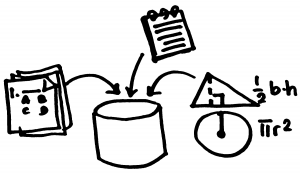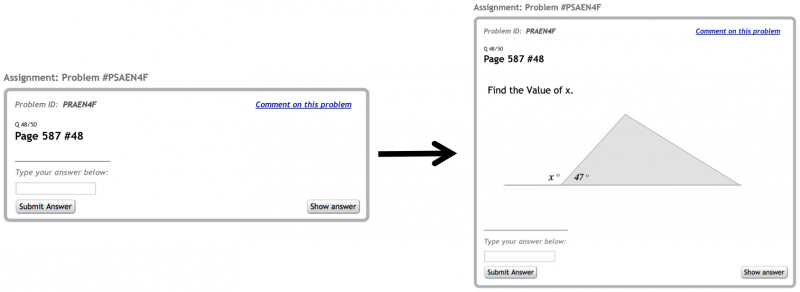Difference between revisions of "All Content In One Place"
Pinventado (talk | contribs) (Add link to data analysis in infobox) |
Pinventado (talk | contribs) |
||
| Line 60: | Line 60: | ||
When a teacher creates a problem in the online learning system, he/she encodes the entire content instead of asking students to browse their book (e.g., Answer problem #48 in page 587 of your textbook). Students will experience less cognitive load compared to constantly switching between reading the problem in the book and the online learning system interface. | When a teacher creates a problem in the online learning system, he/she encodes the entire content instead of asking students to browse their book (e.g., Answer problem #48 in page 587 of your textbook). Students will experience less cognitive load compared to constantly switching between reading the problem in the book and the online learning system interface. | ||
[[File:All_content_in_one_place_ex.png | center]] | [[File:All_content_in_one_place_ex.png | center|800px]] | ||
==References== | ==References== | ||
Revision as of 12:54, 7 July 2015
| All Content In One Place | |
| Contributors | |
|---|---|
| Last modification | July 7, 2015 |
| Source | {{{source}}} |
| Pattern formats | OPR Alexandrian |
| Usability | |
| Learning domain | General |
| Stakeholders | Teachers Students |
| Production | |
| Data analysis | Student affect and interaction behavior in ASSISTments |
| Confidence | |
| Evaluation | PLoP 2015 writing workshop Talk:ASSISTments |
| Application | ASSISTments |
| Applied evaluation | ASSISTments |
If students become bored or disengaged when they are asked to split their attention across multiple resources to solve a problem, then consolidate all necessary references or resources needed to solve the problem in one place for easy access.
Context
Students are asked to answer problems in class or at home in an online learning system. Teachers have control over the content and presentation of each problem in the online learning system.
Problem
Students become bored or disengaged when asked to split their attention across multiple resources to solve a problem.
Forces
- Accessibility. Students may lack access to resources used in the problem (e.g., forgetting to bring their textbook, finding internet access, having access to a computer)
- Split-attention effect. Unnecessary processing of information imposes a cognitive load that interferes with learning. High cognitive load impairs performance, which could increase the difficulty of a learning task (Sweller, 2004[1]).
- Affect. When students experience too much difficulty or get stuck in trying to solve a problem, they are likely to disengage from the activity (D’Mello and Graesser 2012[2]).
Solution
Therefore, consolidate all necessary references or resources needed to solve the problem in one place for easy access.
Resources could be presented in the same page as the problem if it does not up take too much space to display. If the problem uses too many resources, the problem author could Keep it simple by splitting it into multiple problems.
Consequences
Benefits
- Students can access all necessary resources used in the problem.
- Students do not switch between the problem and additional resources.
- Students focus better on problems that are simple and complete.
Liabilities
- Content writers will spend more time and effort in encoding resources into the online learning system.
Evidence
Literature
Several studies have shown that split-attention increases cognitive load and have negative effects on learning in various settings such as: instructional manual usage while learning to use computer software[3], split-attention worked examples for geometry[4], and split-attention worked examples in math word problems[5].
Task switching has also been show to result in slower response times compared to performing a single task, and error-rate is usually higher after the switch[6]. Some of the switch cost sources identified include: time taken by control operations, transient task-set inertia, associative retrieval, or a mix of the three.
Discussion
In a meeting with Ryan Baker and his team at Teacher's College in Columbia University, Neil Heffernan and his team at Worcester Polytechnic Institute, and Peter Scupelli and his team at the School of Design in Carnegie Mellon University (i.e., ASSISTments stakeholders), the team agreed that linking to external content such as textbooks was a notable, recurring design problem. They also considered consolidating content in ASSISTments as a good solution.
David West, the pattern's shepherd at PLoP 2015, also considered the pattern definition acceptable.
Data
According to an analysis of ASSISTments’ data, boredom and gaming behavior correlated with problems that referred students to content in their textbook.
Related patterns
When teachers create problems, they should Keep it simple to minimize the amount of resources used, thus making it easier for students to understand.
Example
When a teacher creates a problem in the online learning system, he/she encodes the entire content instead of asking students to browse their book (e.g., Answer problem #48 in page 587 of your textbook). Students will experience less cognitive load compared to constantly switching between reading the problem in the book and the online learning system interface.
References
- ↑ Sweller, J. (2004). Instructional design consequences of an analogy between evolution by natural selection and human cognitive architecture. Instructional science, 32(1-2), 9-31.
- ↑ D’Mello, S., and Graesser, A. (2012). Dynamics of affective states during complex learning. Learning and Instruction, 22(2), 145-157.
- ↑ Cerpa, N., Chandler, P., and Sweller, J. (1996). Some conditions under which integrated computer-based training software can facilitate learning. Journal of Educational Computing Research, 15, 345-368.
- ↑ Sweller, J., Chandler, P., Tierney, P., and Cooper, M. (1990). Cognitive load as a factor in the structuring of technical material. Journal of Experimental Psychology: General, 119(2), 176.
- ↑ Mwangi, W., and Sweller, J. (1998). Learning to solve compare word problems: The effect of example format and generating self-explanations. Cognition and instruction, 16(2), 173-199.
- ↑ Monsell, S. (2003). Task switching. Trends in cognitive sciences, 7(3), 134-140.

